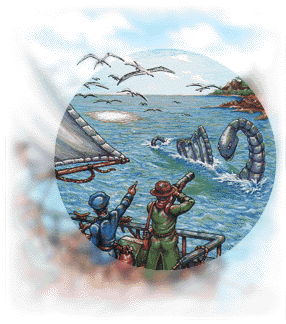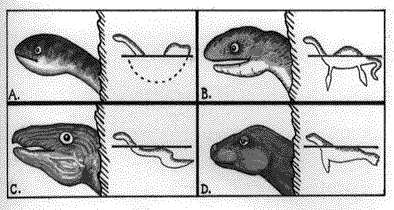
Illustration: Bill Herd
The Definitive Sea Serpent
by Matthew A. Bille
Are there still large unclassified animals roaming the oceans of the world? The average zoologist would say "probably not." But two particular zoologists, were they still with us, would emphatically disagree. In 1905, Michael J. Nicoll and E. G. B. Meade-Waldo observed a"sea monster" which has never been caught, classified, or explained.
The Sighting
The chief witnesses in this amazing yet little-remembered encounter were experienced British naturalists, Fellows of the Zoological Society of London best known for their work in ornithology. Their account of "a creature of most extraordinary form and proportions" is recorded in the 1906 edition of the Society's Proceedings and in Nicoll's 1908 book Three Voyages of A Naturalist.
On December 7, 1905, at 10:15 AM, Nicoll and Meade-Waldo were on a research cruise aboard the yacht Valhalla. Fifteen miles east of the mouth of Brazil's Parahiba River, Nicoll spotted a large dorsal fin which "resembled that of no fish I had previously seen."
Nicoll turned to his companion and asked, "Is that the fin of a great fish?" Meade-Waldo looked. The fin was cruising past them about a hundred yards from the yacht. Meade-Waldo described it as "dark seaweed-brown, somewhat crinkled at the edge." The visible part of the fin was roughly rectangular, about six feet long and eighteen inches to two feet high.
Meade-Waldo turned his binoculars on the object, and immediately a head on a long neck rose from the water in front of the frill. He estimated the neck was "about the thickness of a slight man's body, and from 7 to 8 feet was out of the water; head and neck were all about the same thickness."
The head had a very turtle-like appearance, as also the eye," Meade-Waldo wrote of the incident. It moved its head and neck from side to side in a peculiar manner: the color of the head and neck was dark brown above, and whitish below-almost white, I think."
The neck threw up a significant wave where it entered the water, and Nicoll noted that, "Below the water we could indistinctly see a very large brownish-black patch, but could not make out the shape of the creature."
Nicoll added, "This creature was an example, I consider, of what has been so often reported, for want of a better name, as the 'great sea-serpent.'"
In a 1929 letter to sea-serpent writer Rupert T. Gould, Meade-Waldo added that "I will never forget poor Nicoll's face of amazement when we looked at each other after we had passed out of sight of it." Gould gave the case a very thorough treatment in his meticulous if partisan book, The Case for the Sea-Serpent, published in 1930.
The original sighting lasted for several minutes. The Valhalla drew away from the creature, and the yacht was traveling under sail and could not come about to pursue. At 2:00 AM on December 8th, however, three crewmembers saw what appeared to be the same animal, almost entirely submerged, overtaking and passing the Valhalla at a speed of about nine knots.
That, in brief, is the story of the most important sighting in the long and controversial history of the sea-serpent.
So what did the witnesses see?
Skeptics often explain sea-monster reports as misidentifications of known animals, floating debris, etc. Very often, they are undoubtedly correct. On this report, however, the response from skeptics was a deafening silence. Neither then nor since has a "non-monstrous" explanation been offered.
There is no logical reason to doubt that the observers saw an unknown marine animal. The observing conditions were perfect and the witnesses highly qualified. It would be hard to wish for better testimonial evidence.
IDENTITY

Comparison of head profiles of:
a.Valhalla animal
b.Pleisiosaur
c . Common eel
d. Leopard seal
If we accept that an unknown animal was involved, what are we to make of it?
The first question to consider is what class of animal the thing could belong to. No one has suggested an amphibian, a bird, or any type of invertebrate. That leaves mammals, reptiles, and fish to choose from.
Meade-Waldo thought the beast's head was "turtle-like" but offered no specific theory as to what type animal it was. While Nicoll also thought the head reminiscent of a turtle's, he believed the creature was a mammal. "It is of course, impossible to be certain of this," he admitted, "but the general appearance of the creature, especially the soft, almost rubber-like fin, gave one this impression."

Classifying the creature is made more difficult because Nicoll and Meade-Waldo did not observe details that would have narrowed the possibilities: there is no mention of gills, hair, external ears, pectoral fins, mammae, or nostrils in their accounts. Leading cryptozoologist Bernard Heuvelmans, in his classic tome In the Wake of the Sea-Serpents note that Nicoll's sketch shows the creature's mouth ending directly below the eye. In reptiles, the mouth normally continues back beyond the eye. In mammals, it does not.
There is no hard and fast rule for fish. Heuvelmans, noting that eels and some other fish have relatively soft dorsal fins which flex as the body moves, suggests the sighting involved the sea monster type he calls the "super-eel," an eel or eel-shaped fish swimming with its head and forebody out of the water. Some known species of eels do swim this way on occasion, although the reason for such behavior is unclear.
Another logical candidate might be a reptile. Nicoll's sketch certainly bear some resemblance to a long-extinct plesiosaur. The suborder Plesiosauria was a very successful group during the Age of Reptiles. It included dozen of species, the largest perhaps fifty feet long. A descendant of the plesiosaurs was Gould's favorite theory, although he also suggested the Valhalla sighting could have involved a "turtle-like creature."
In addition to Heuvelmans' note about the mouth, however, no plesiosaur is known to have possessed a dorsal fin. With their wide, turtle-shaped bodies, they would not need one for stability. It is conceivable that some types had an ornamental fin used for display when facing a threat or attracting a mate, but this is pure speculation.
Paleontologist Robert Bakker has recently argued that plesiosaurs did not, as once believed, sail unaffected through the extinctions which punctuated the Age of Reptiles. Instead, the true plesiosaurs died out at the end of the Jurassic period, and lookalike reptiles quickly evolved to take their ecological niche. This is an important point because the traditional view had buttressed the idea that plesiosaurs might have also survived the K-T extinction at the end of the Mesozoic era and lived on to the present day.
Nicoll's original idea that the beast was a mammal has problems as well. There is no known mammal, living or extinct, which resembles this long-necked creature, although our knowledge of the fossil record is necessarily incomplete. One could hypothesize that the serpentine prehistoric whales known as zeuglodons might have developed a long-necked form. The objection to this is that zeuglodons were in fact evolving in the other direction, resulting in the almost total disappearance of the neck in modern whales. An alternative idea is that the Valhalla incident involved a huge elongated seal. However, no known seal has a dorsal fin. (Whether some zeuglodon possessed them is not certain. )
SEA SERPENTS COMPARED
How does this creature compare to other authoritative sea-serpent reports? Meade-Waldo was aware of the famous 1848 sighting by the crew of the frigate HMS Daedalus. He commented that his own creature "might easily be the same." The Daedalus witnesses reported an animal resembling "a large snake or eel with a visible length of 60 feet. Captain Peter McQuahe saw what he thought was a mane on its back, while his subordinate, Lieutenant Drummond, thought the feature was a dorsal fin. Some fish lay the dorsal fin back flat when swimming at high speed: an officer on the Daedalus estimated the creature they saw was making an estimated ten miles an hour and creating a noticeable bow-wave.
In fact, reports of dorsal fin are not at all common in the better-documented sea-serpent cases. Nor do those which are reported necessarily match the squarish fin described in the Valhalla case. For example, the crew of the merchant cruiser Hilary, who reported using a sea monster for target practice in 1917, described a triangular dorsal fin.
ARE THERE GIANT EELS?
If one of the candidates for the Valhalla sighting is a giant eel, then we should have other giant-eel sightings on record. There are a few. A German vessel, the Kaiserin Augusta Victoria, observed such a creature in its entirety off England in 1912. The Kaiserin's Captain Ruser described it as twenty feet long and about eighteen inches thick. In 1947, the Grace liner Santa Clara ran over a brown eel-like creature estimated at 60 feet long. Finally, Heuvelmans add an account of some tourists who went spearfishing in the Mediterranean in 1958. They allegedly had a very close encounter with a creature like a giant moray eel, which literally scared them out of the water. Any discussion of the giant eel theory must mention the six-foot long leptocephalus, or eel larvae, collected by the research vessel Dana in 1930. A normal leptocephalus is only three inches long. Some forty years after the Dana specimen was netted, however, it was reclassified as the larva of an eellike deep-sea fish belonging to a group called noticanthiforms. Known noticanthiforms don't change much in size during the metamorphosis from larva to adult: the ratio in this still-unidentified species is not certain.
SORTING IT ALL OUT
Heuvelmans' compilation of 358 "significant" reports includes at least a dozen which may concern the same creature as in the Valhalla case, although no other report matches this one in every detail. This is a familiar obstacle for partisans of the sea-serpent. Every case is different, and the witnesses in these hundreds of cases could not possibly all have been describing the same species. To skeptics, this is evidence of hoax or error. To Heuvelmans, it indicates there are several types of animals involved: as many as nine, according to his book.
The idea of an entire seaquarium of monsters cruising the seven seas is understandably difficult to swallow. Still, there is nothing outrageous about the idea of one or two unknowns remaining at large. There had never been a sighting of a megamouth shark (Megachasma pelagios) before the first specimen was caught, quite by accident, in 1976. The Indopacific beaked whale ( Indopacetus pacificus) known from two skulls found 29 years and thousands of miles apart. There are no confirmed sightings of the whole animal, alive or dead. The Peruvian beaked whale (Mesoplodon peruvians) was unknown to science until 1976 and not formally described until 1990. No one can state with certainty that the oceans hold no more surprises.
If this still sounds like inconclusive speculation, it is. Until we have a body, or, at the least, closeup photographic evidence, what Willy Ley called "the great unknown of the seas" will continue to frustrate all attempts at definitive classification.
We are left with this simple fact: on December 7th, 1905, two well-qualified witnesses observed a large unknown marine animal. Their report stands as irrefutable if incomplete evidence that the oceans hold at least one spectacular creature still evading the probes of science.
REFERENCES
- Anonymous, "Giant Leptocephalus," Nature, April 2, 1971, pp. 278-9
- Bakker, Robert, "Jurassic Sea Monsters," Discover, September, 1993, pp. 78-85.
- Binns, Ronald, The Loch Ness Mystery-Solved (Shepton Mallet: Open Books), 1983.
- Gould, Rupert T., The Case for the Sea-Serpent (London: Phillip Allan), 1930.
- Heuvelmans, Bernard, In the Wake of the Sea Serpents (New York: Hill and Wang), 1968.
- Mackal, Roy P., The Monsters of Loch Ness (Chicago: Swallow Press), 1976.
- Meade-Waldo, E.G.B., and Nicoll, Michael J., "Description of an Unknown Animal Seen at Sea off the Coast of Brazil," Proceedings of the Zoological Society of London, vol. 2, 1906, pp. 719-21. (Quoted in Nicoll, below)
- Nicoll, Michael J., Three Voyages of a Naturalist (London: Witherby & Co.), 1908.